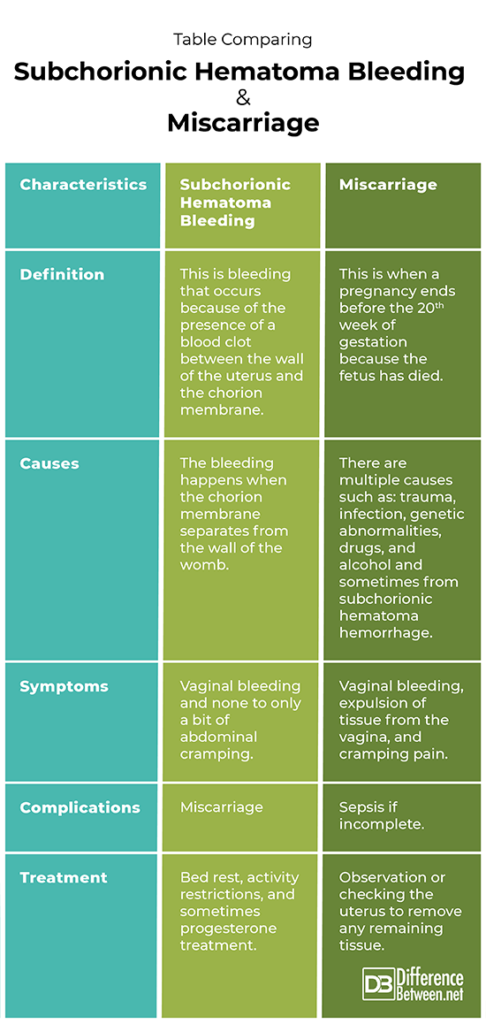Difference Between Subchorionic Hematoma Bleeding and Miscarriage
Subchorionic bleeding is hemorrhage due to a clot that forms between the chorion membrane and uterus. A miscarriage is when bleeding happens due to a death of the fetus in utero.

What is Subchorionic hematoma bleeding?
Definition:
Subchorionic hematoma bleeding is when bleeding occurs due to the presence of a blood clot between the wall of the uterus and the chorion membrane.
Causes:
The bleeding of a subchorionic hematoma happens when the chorion membrane partly separates from the wall of the uterus. It is a fairly common occurrence and cause of bleeding in pregnant women.
Symptoms and complications:
Symptoms are bleeding from the vagina; usually there is no pain but very rarely a woman may feel cramps. There is a slightly increased risk of either preterm delivery or miscarriage if a woman has subchorionic hematoma bleeding.
Diagnosis:
Diagnosis of subchorionic hematoma bleeding is commonly achieved by performing an ultrasound on the woman and noting the presence of fluid (blood) between the chorion membrane and the uterine wall.
Treatment:
The main concern with the bleeding is the potential for a miscarriage to occur. Woman may be encouraged to go on bed rest and not to stay standing for any length of time and not to exercise. Such activity restrictions are placed on women with large hematomas. Progesterone is sometimes given.

What is Miscarriage?
Definition:
A miscarriage is the event when a pregnancy ends before week 20 of gestation due to fetal death. It is also referred to as a spontaneous abortion because the body naturally expels a deceased fetus.
Causes:
There are many causes of miscarriage. Genetic abnormalities in a fetus can sometimes result in a miscarriage. Other causes include trauma, infection, the use of alcohol or drugs, or a structural anomaly of the reproductive organs. Another cause of miscarriages is having a condition called antiphospholipid antibody syndrome. Most miscarriages happen in the first trimester of pregnancy.
Symptoms and complications:
Symptoms of a miscarriage includes cramping pain in the abdomen along with the passing of blood and tissue out of the vagina. Bleeding is often heavy only if it is a later stage of pregnancy. Very early miscarriages typically only have light bleeding. One of the first signs may be a sudden passing of fluid through the vagina. Complications can happen if remains stay in the vagina leading to infection. This can result in sepsis, which can be life-threating.
Diagnosis:
Diagnosis is based on the symptoms and levels of the hormone human chorionic gonadotropin (beta-hCG). An ultrasound can also be used to indicate that a miscarriage has taken place and will show absence of the fetal pole.
Treatment:
A threatened miscarriage requires careful watch of what is happening with the pregnancy. When a miscarriage has occurred, the uterus needs to be examined and any remaining tissue removed to prevent future problems such as infections.
Difference betweenSubchorionic hematoma bleeding and Miscarriage?
Definition
A subchorionic hematoma bleeding is when is bleeding occurs because of the presence of a blood clot between the wall of the uterus and the chorion membrane. A miscarriage is when a pregnancy ends naturally before week 20 of gestation.
Causes
A subchorionic hematoma bleeds when the wall of the uterus separates from the chorion membrane. A miscarriage can be caused by many things including alcohol, drugs, infection, trauma, and genetic problems.
Symptoms
Symptoms of subchorionic hematoma bleeding include vaginal bleeding without cramps or with very minor cramping pain. Symptoms of a miscarriage is the passing of blood and tissue through the vagina, and cramping pain in the abdomen.
Complications
A complication of subchorionic hematoma bleeding is a miscarriage. A complication of a miscarriage is infection and sepsis.
Treatment
The treatment of subchorionic hematoma bleeding may be bed rest and progesterone therapy. The treatment of miscarriage involves checking the uterus to ensure all remaining tissue is removed.
Table comparing Subchorionic hematoma bleeding and Miscarriage

Summary of Subchorionic hematoma bleeding Vs. Miscarriage
- A subchorionic hematoma bleed sometimes happens in pregnant women, and can increase the chances of a miscarriage.
- A miscarriage is loss of a fetus due to some problem that has occurred.
- Both a subchorionic hematoma and a miscarriage can cause vaginal bleeding.
FAQ
Does subchorionic hemorrhage mean miscarriage?
A subchorionic hemorrhage does not always mean miscarriage, as it depends on the extent of bleeding and other factors. It does, however, increase the likelihood of a miscarriage, especially if the bleeding is significant.
What does bleeding from a subchorionic hemorrhage look like?
The bleeding varies from light pink or red spotting to heavy bright red blood with clots present.
What does subchorionic hematoma discharge look like?
The hematoma discharge can appear red or brown.
How long did you bleed with subchorionic hematoma?
Bleeding from a subchorionic hematoma may occur on and off until a woman enters the second trimester.
How much bleeding is normal with a subchorionic hemorrhage?
The amount of bleeding is variable. Some women have only light bleeding when they have a subchorionic hemorrhage while others have heavy blood loss.
What are the chances of miscarriage with subchorionic hematoma?
There is about a 17.6% chance of a miscarriage if a pregnant woman has a subchorionic hematoma that bleeds.
- Difference Between Rumination and Regurgitation - June 13, 2024
- Difference Between Pyelectasis and Hydronephrosis - June 4, 2024
- Difference Between Cellulitis and Erysipelas - June 1, 2024
Search DifferenceBetween.net :
Leave a Response
References :
[0]Bondick, Christopher P., and H. Fertel. "Subchorionic Hemorrhage." NIH, 2020, https://www.ncbi.nlm.nih.gov/books/NBK559017/
[1]Dulay, Antonette T. “Spontaneous abortion (miscarriage)”. Merckmanuals. Merck & Co., 2022, https://www.msdmanuals.com/professional/gynecology-and-obstetrics/abnormalities-of-pregnancy/spontaneous-abortion
[2]Şükür, Yavuz Emre, et al. "The effects of subchorionic hematoma on pregnancy outcome in patients with threatened abortion." Journal of the Turkish German Gynecological Association 15.4 (2014): 239.
